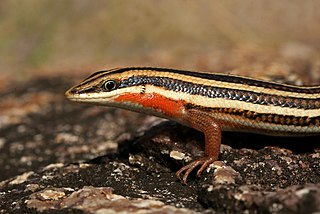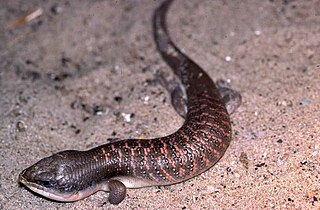
Asymblepharus is a genus of skinks. The genus has been confused with and is very similar to Scincella.

The genus Eumeces comprises four African to Middle-Eastern skink species.
Feylinia is a genus of skinks. It is usually placed in the monotypic subfamily Feylininae.

Mesoscincus is a genus of lizards, comprising three species of skinks native to Mexico and Central America. The species were formerly included in the genus Eumeces.
Eumeces blythianus, commonly known as Blyth's skink, is a species of skink endemic to South Asia.

Eumeces schneiderii, commonly known as Schneider's skink or the Berber skink, is a species of lizard in the family Scincidae. The species is endemic to Central Asia, Western Asia, and North Africa. There are five recognized subspecies.
Eurylepis poonaensis, the Poona skink, is a species of skink found only in Maharashtra, India.
The striped grass mabuya, also called striped grass skink, is a species of skink found in South Asia.

The bronze grass skink, bronze mabuya or speckled forest skink, is a species of skink found in South and Southeast Asia. It is a common, but shy, ground-dwelling species that is active both day and night.

Sharma's mabuya is a species of skinks found in India. It was described by Sharma (1969) from hills south of Vijaypuri on the right bank of the river Krishna in Andhra Pradesh.
Ophiomorus tridactylus, commonly known as the three-toed snake skink, is a species of skink endemic to sandy desert areas of South Asia. It is also called the Indian sand-swimmer for its habit of moving just under the sand.

Plestiodon is a genus of lizards in the family Scincidae (skinks). The genus contains many species formerly classified under the genus Eumeces, except those now placed in Mesoscincus. They are secretive, agile animals with a cylindrical body covered with smooth, shiny scales. They are distributed from East Asia to throughout North America from southern Canada south to Mexico, including oceanic islands such as Bermuda.

Eumeces algeriensis, commonly called the Algerian skink, Algerian orange-tailed skink, Berber's skink, in French eumece d'Algérie, or in Spanish bulán, is a species of skink in the family Scincidae. The species is endemic to the Maghreb region of North Africa.

Trachylepis is a skink genus in the subfamily Lygosominae found mainly in Africa. Its members were formerly included in the "wastebin taxon" Mabuya, and for some time in Euprepis. As defined today, Trachylepis contains the clade of Afro-Malagasy mabuyas. The genus also contains a species from the Brazilian island of Fernando de Noronha, T. atlantica, and may occur in mainland South America with Trachylepis tschudii and Trachylepis maculata, both poorly known and enigmatic. The ancestors of T. atlantica are believed to have rafted across the Atlantic from Africa during the last 9 million years.

Scincinae is a subfamily of lizards. The subfamily contains 33 genera, and the genera contain a combined total of 284 species, commonly called skinks. The systematics is at times controversial. The group is probably paraphyletic. It is one of three subfamilies of the family Scincidae, the other two being Acontinae and Lygosominae.

Eutropis is a genus of skinks belonging to the subfamily Mabuyinae. For long, this genus was included in the "wastebin taxon" Mabuya; it contains the Asian mabuyas. They often share their habitat with the related common skinks (Sphenomorphus), but they do not compete significantly as their ecological niches differ. This genus also contains the only member of the subfamily to occur in Australasia, the many-lined sun skink, whose wide range includes New Guinea.
Taylor's striped mabuya is a species of skink endemic to island of Sri Lanka.
The Tepalcatepec skink is a species of lizard in the family Scincidae. The species is endemic to Mexico.









